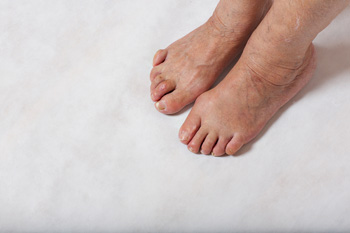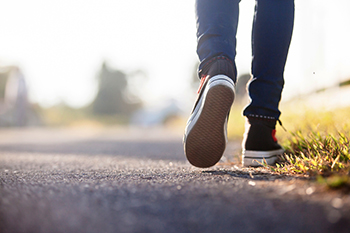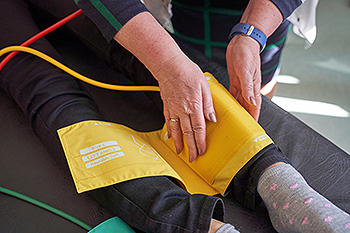August 2021
What Are Hammertoes?
Hammertoes are a common deformity in which the second, third, fourth, or fifth toes bend downward at the middle joint. This gives the affected toes a hammer-like appearance. They may also be referred to as claw toes, mallet toes, or retracted toes. This deformity is said to be more common among people who have bunions or high arches. Wearing poorly-fitted shoes and socks that squish the toes together can exacerbate the problem as well. Hammertoes can be stiff and painful. Over time, the toe joints can lose their flexibility and you may be unable to straighten the toes without surgical intervention. People with hammertoes also often notice corns and calluses forming at the tops of their toes, where the skin over the bent toes rubs against shoes. If you are suffering from hammertoes it is suggested that you seek the care of a podiatrist.
Hammertoe
Hammertoes can be a painful condition to live with. For more information, contact Dr. Ronald K. Olm from Grand Traverse Foot & Ankle Center. Our doctor will answer any of your foot- and ankle-related questions.
Hammertoe is a foot deformity that affects the joints of the second, third, fourth, or fifth toes of your feet. It is a painful foot condition in which these toes curl and arch up, which can often lead to pain when wearing footwear.
Symptoms
- Pain in the affected toes
- Development of corns or calluses due to friction
- Inflammation
- Redness
- Contracture of the toes
Causes
Genetics – People who are genetically predisposed to hammertoe are often more susceptible
Arthritis – Because arthritis affects the joints in your toes, further deformities stemming from arthritis can occur
Trauma – Direct trauma to the toes could potentially lead to hammertoe
Ill-fitting shoes – Undue pressure on the front of the toes from ill-fitting shoes can potentially lead to the development of hammertoe
Treatment
Orthotics – Custom made inserts can be used to help relieve pressure placed on the toes and therefore relieve some of the pain associated with it
Medications – Oral medications such as anti-inflammatories or NSAIDs could be used to treat the pain and inflammation hammertoes causes. Injections of corticosteroids are also sometimes used
Surgery – In more severe cases where the hammertoes have become more rigid, foot surgery is a potential option
If you have any questions please contact one of our offices located in Traverse City and Kalkaska, MI . We offer the newest diagnostic and treatment technologies for all your foot and ankle needs.
Can I Wear Running Shoes for Walking Too?
If you are new to the world of working out, you may be wondering what type of shoes to get. Running shoes are often found in shoe stores, but what if you just want to walk? Can you still wear running shoes? The answer is yes, but you may want to consider the differences between running and walking shoes. Running shoes have more cushioning and support than walking shoes. This is to protect the feet against the pounding and stronger impacts that occur while running. Running shoes are also less flexible than walking shoes. Finally, because running generates more heat than walking, running shoes are generally made of more breathable materials than walking shoes. Unfortunately, walking shoes can be more difficult to find than running shoes. Stores that sell them often have a limited selection of styles and colors relative to other types of shoes. If you are unsure of what kind of shoes would best suit your needs, a podiatrist can examine your feet and provide you with suggestions on what to look for when shopping for the right pair of shoes for you.
For more information about walking shoes versus running shoes, consult with Dr. Ronald K. Olm from Grand Traverse Foot & Ankle Center. Our doctor can measure your feet to determine what your needs are and help you find an appropriate pair of footwear.
Foot Health: The Differences between Walking & Running Shoes
There are great ways to stay in shape: running and walking are two great exercises to a healthy lifestyle. It is important to know that running shoes and walking shoes are not interchangeable. There is a key difference on how the feet hit the ground when someone is running or walking. This is why one should be aware that a shoe is designed differently for each activity.
You may be asking yourself what the real differences are between walking and running shoes and the answers may shock you.
Differences
Walking doesn’t involve as much stress or impact on the feet as running does. However, this doesn’t mean that you should be any less prepared. When you’re walking, you land on your heels and have your foot roll forward. This rolling motion requires additional support to the feet.
Flexibility – Walking shoes are designed to have soft, flexible soles. This allows the walker to push off easily with each step.
If you have any questions, please feel free to contact one of our offices located in Traverse City and Kalkaska, MI . We offer the newest diagnostic and treatment technologies for all your foot care needs.
What is PAD (Peripheral Artery Disease)?
Millions of people in the United States suffer from peripheral artery disease (PAD), which is a narrowing of the arteries in the extremities and other areas of the body (excluding the heart and brain). PAD is most typically caused by an accumulation of fatty material in the arteries (atherosclerosis). PAD can restrict blood flow to the legs and feet where symptoms are often present, including: cold feet, a loss of hair on the legs and feet, skin that has a shiny appearance, toenails that are brittle or grow slowly, sores on the feet or legs that don’t heal, weakness in the legs, difficulty finding a pulse in the foot or leg, and more. It is important to be properly diagnosed and treated early to avoid more dangerous conditions from developing and to reduce the risk of stroke and heart attack. If you are exhibiting any of the symptoms described, it is suggested that you make an appointment with a podiatrist as soon as possible.
Peripheral artery disease can pose a serious risk to your health. It can increase the risk of stroke and heart attack. If you have symptoms of peripheral artery disease, consult with Dr. Ronald K. Olm from Grand Traverse Foot & Ankle Center. Our doctor will assess your condition and provide you with quality foot and ankle treatment.
Peripheral artery disease (PAD) is when arteries are constricted due to plaque (fatty deposits) build-up. This results in less blood flow to the legs and other extremities. The main cause of PAD is atherosclerosis, in which plaque builds up in the arteries.
Symptoms
Symptoms of PAD include:
- Claudication (leg pain from walking)
- Numbness in legs
- Decrease in growth of leg hair and toenails
- Paleness of the skin
- Erectile dysfunction
- Sores and wounds on legs and feet that won’t heal
- Coldness in one leg
It is important to note that a majority of individuals never show any symptoms of PAD.
Diagnosis
While PAD occurs in the legs and arteries, Podiatrists can diagnose PAD. Podiatrists utilize a test called an ankle-brachial index (ABI). An ABI test compares blood pressure in your arm to you ankle to see if any abnormality occurs. Ultrasound and imaging devices may also be used.
Treatment
Fortunately, lifestyle changes such as maintaining a healthy diet, exercising, managing cholesterol and blood sugar levels, and quitting smoking, can all treat PAD. Medications that prevent clots from occurring can be prescribed. Finally, in some cases, surgery may be recommended.
If you have any questions, please feel free to contact one of our offices located in Traverse City and Kalkaska, MI . We offer the newest diagnostic and treatment technologies for all your foot care needs.
Plantar Warts Can Be Treated!
What is an Acute Running Injury?
 Research has indicated that a staggering sixty percent of people who enjoy running have endured a running injury in the past year. These injuries may be the result of inconsistent training and possibly from increasing speed and distance too soon. An acute running injury is generally traumatic and happens suddenly. Now you're probably wondering what an acute running injury is. Most commonly they are strains and sprains, but can also be a muscle tear, bone crack, or ligament snap. Other running injuries may include plantar fascitiis, heel spurs, stress fractures, ankle sprains, and Achilles tendonitis. Whether a runner falls, twists an ankle, or gets struck by a vehicle, it's usually painful and associated with a "popping" sound followed by inflammation. Additionally, the foot may have a limited range of motion, and it may be difficult to walk. Runners may be able to prevent these injuries by paying attention to the type of ground they’re running on, being aware of their surroundings, and stretching before and after a run. There are many painful foot conditions that can occur from running injuries, and it is strongly suggested that you consult with a podiatrist who can provide helpful suggestions on how to prevent running injuries.
Research has indicated that a staggering sixty percent of people who enjoy running have endured a running injury in the past year. These injuries may be the result of inconsistent training and possibly from increasing speed and distance too soon. An acute running injury is generally traumatic and happens suddenly. Now you're probably wondering what an acute running injury is. Most commonly they are strains and sprains, but can also be a muscle tear, bone crack, or ligament snap. Other running injuries may include plantar fascitiis, heel spurs, stress fractures, ankle sprains, and Achilles tendonitis. Whether a runner falls, twists an ankle, or gets struck by a vehicle, it's usually painful and associated with a "popping" sound followed by inflammation. Additionally, the foot may have a limited range of motion, and it may be difficult to walk. Runners may be able to prevent these injuries by paying attention to the type of ground they’re running on, being aware of their surroundings, and stretching before and after a run. There are many painful foot conditions that can occur from running injuries, and it is strongly suggested that you consult with a podiatrist who can provide helpful suggestions on how to prevent running injuries.
All runners should take extra precaution when trying to avoid injury. If you have any concerns about your feet, contact Dr. Ronald K. Olm of Grand Traverse Foot & Ankle Center. Our doctor will treat your foot and ankle needs.
How to Prevent Running Injuries
There are a lot of mistakes a runner can make prior to a workout that can induce injury. A lot of athletes tend to overstretch before running, instead of saving those workouts for a post-run routine. Deep lunges and hand-to-toe hamstring pulls should be performed after a workout instead of during a warmup. Another common mistake is jumping into an intense routine before your body is physically prepared for it. You should try to ease your way into long-distance running instead of forcing yourself to rush into it.
More Tips for Preventing Injury
- Incorporate Strength Training into Workouts - This will help improve the body’s overall athleticism
- Improve and Maintain Your Flexibility – Stretching everyday will help improve overall performance
- “Warm Up” Before Running and “Cool Down” Afterward – A warm up of 5-10 minutes helps get rid of lactic acid in the muscles and prevents delayed muscle soreness
- Cross-Training is Crucial
- Wear Proper Running Shoes
- Have a Formal Gait Analysis – Poor biomechanics can easily cause injury
If you have any questions, please feel free to contact one of our offices located in Traverse City and Kalkaska, MI . We offer the newest diagnostic and treatment technologies for all your foot care needs.
What Causes Heel Pain?
 Heel pain can have a variety of causes that range from bone damage like a bone bruise or stress fracture, to structural issues like plantar fasciitis or Achilles tendonitis. Plantar fasciitis is the most common cause of heel pain, and this occurs when the plantar fascia, which connects the heel to the toes along the bottom of the foot, becomes inflamed or torn. Children who are experiencing heel pain may be suffering from Sever’s disease. Sever’s disease occurs in active teenagers when the growth plate in the heel becomes inflamed. Patients who are struggling with heel pain should consult with a podiatrist for diagnosis. Upon diagnosis, a proper treatment method will be provided by your podiatrist.
Heel pain can have a variety of causes that range from bone damage like a bone bruise or stress fracture, to structural issues like plantar fasciitis or Achilles tendonitis. Plantar fasciitis is the most common cause of heel pain, and this occurs when the plantar fascia, which connects the heel to the toes along the bottom of the foot, becomes inflamed or torn. Children who are experiencing heel pain may be suffering from Sever’s disease. Sever’s disease occurs in active teenagers when the growth plate in the heel becomes inflamed. Patients who are struggling with heel pain should consult with a podiatrist for diagnosis. Upon diagnosis, a proper treatment method will be provided by your podiatrist.
Many people suffer from bouts of heel pain. For more information, contact Dr. Ronald K. Olm of Grand Traverse Foot & Ankle Center. Our doctor can provide the care you need to keep you pain-free and on your feet.
Causes of Heel Pain
Heel pain is often associated with plantar fasciitis. The plantar fascia is a band of tissues that extends along the bottom of the foot. A rip or tear in this ligament can cause inflammation of the tissue.
Achilles tendonitis is another cause of heel pain. Inflammation of the Achilles tendon will cause pain from fractures and muscle tearing. Lack of flexibility is also another symptom.
Heel spurs are another cause of pain. When the tissues of the plantar fascia undergo a great deal of stress, it can lead to ligament separation from the heel bone, causing heel spurs.
Why Might Heel Pain Occur?
- Wearing ill-fitting shoes
- Wearing non-supportive shoes
- Weight change
- Excessive running
Treatments
Heel pain should be treated as soon as possible for immediate results. Keeping your feet in a stress-free environment will help. If you suffer from Achilles tendonitis or plantar fasciitis, applying ice will reduce the swelling. Stretching before an exercise like running will help the muscles. Using all these tips will help make heel pain a condition of the past.
If you have any questions please contact one of our offices located in Traverse City and Kalkaska, MI . We offer the newest diagnostic and treatment technologies for all your foot and ankle needs.









